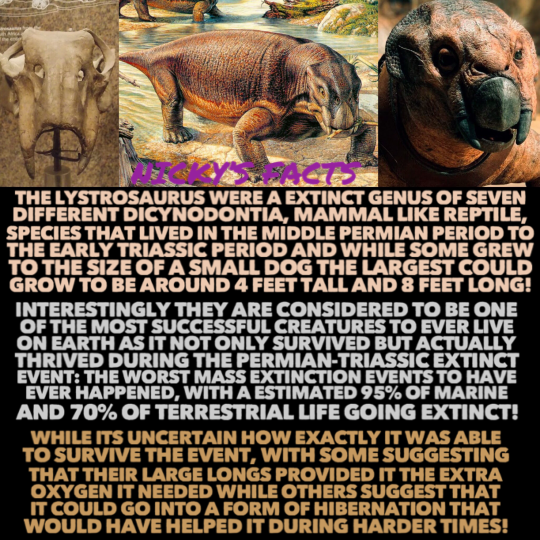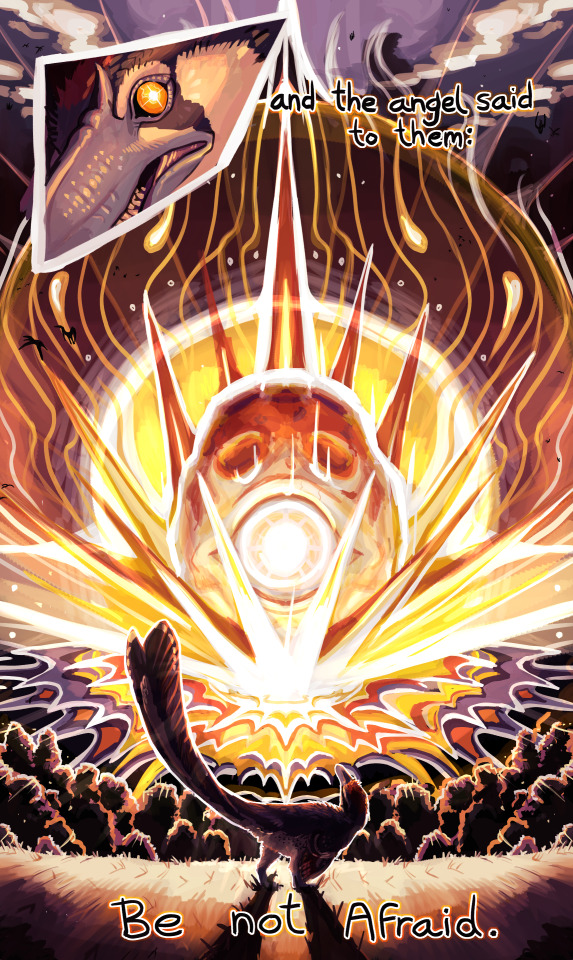#extinction event
Text

#lmao#biology meme#biology memes#biology#je pense#science#extinction#mass extinction#extinction event#bio#paleohistory#paleontology#paleontology memes#science memes#bio memes#memes
164 notes
·
View notes
Text
How fucking boring our extinction event is truck and shipping exhaust plus microplastic
And not something rad as fuck like alien invasion that matrixs us
Or like
A zombie invasion but realistic rotting and decomposition so like introverts would be alright cause we only leave the house once a month any ways and people decompose way quicker than you'd expect
Plus a giant meteor would be cool too
20 notes
·
View notes
Text

would you still like me if i had no skin and was a dakotaraptor??
#artists on tumblr#illustrators on tumblr#concept art#dinosaur#meteor#asteroid#extinction#extinction event#dakotaraptor#raptor#space#art#illustration
76 notes
·
View notes
Text

Human Ancestors Bottleneck: a human genomics analysis has shown that the total population of direct-line human ancestors plummeted to about 1,280 breeding individuals for a span of about 117,000 years, bringing them close to extinction:
#history#historyfiles#archaeology#hominid chronology#africa#genomics#homo ergaster#human ancestors#early humans#bottleneck#extinction#extinction event#archaeological
7 notes
·
View notes
Photo

10 notes
·
View notes
Text

The Lystrosaurus were the adorable survivalists of the Triassic period!
😍
#history#lystrosaurus#jurassic world#jw#extinct#prehistoric animals#dicynodontia#triassic#pangea#jurassic world evolution#jwe#permian trassic extinction event#survivalist#fossils#permian#walking with monsters#prehistoric#extinct animals#paleontology#extinction event#nickys facts
11 notes
·
View notes
Text

a quick, colored and shaded drawing of Eden Trias, member of "The Big 5", a mysterious group of characters based on extinction events of earth's past, really cool designs, especially Eden here!
------
un rápido, coloreado y sombreado dibujo de Eden Trias, miembro de "Los 5 Grandes", un misterioso grupo de personajes basados en eventos de extinción del pasado de la tierra, tienen unos diseños realmente geniales, especialmente Eden aquí!
---
Eden Trias by Funamusea
#funamusea#okegom#deep sea prisoner#funamuseart#my art#eden trias#eden#trias#the big five#big five#triassic#jurassic#obscure characters#toga#toga dress#toga clothing#extinction event
2 notes
·
View notes
Text
Dinofact #20
The most supported theory of the cause of the Cretaceous-Paleogene Extinction Event is the bolide impact hypothesis, which states that most the dinosaurs (excepting aves, modern-day birds) were extincted by a meteor impact. This theory, proposed by Walter Alvarez, Luis Alvarez, and colleagues in 1980, is supported by increased iridium deposits worldwide and the Cretaceous-Paleogene boundary, as well as shocked quartz, also found worldwide. In 1991, a massive crater measuring 180 km (110 mi) wide was discovered in the Yucatán Peninsula of southeastern Mexico. Evidence suggests that an extraterrestrial projectile approximately 5 to 15 kilometers (3 to 9+1⁄2 miles) wide impacted the site 66 million years ago, causing a chain of tsunamis, earthquakes, wildfires, and other disasters, that led to an "impact winter", leading to the extinction of all dinosaurs except for grain-eating birds.
Sources: wikipedia, the Smithsonian Magazine
#dinosaur#dinosaurs#paleontology#birds#extinction#dinosaur extinction#extinction event#cretaceous–paleogene extinction event#walter alvarez#luis alvarez#chicxulub#chicxulub crater#chicxulub impact#yucatan#yucatán#yucatan peninsula#yucatán peninsula#mexico#southeast mexico#trivia#fun facts#dinosaur fun facts#dinosaur trivia#13th#september#2022#september 13th#september 2022#september 13th 2022
7 notes
·
View notes
Text

#climate catastrophe#climate emergency#climate change#disaster#eschatology#end times#dystopia#extinction event#death#we're all going to die#there will be no one left to remember our stories#depression#anxiety#antinatalism#the forecast
4 notes
·
View notes
Text

Chicxulub impact
0 notes
Text
Deity who's unacquainted with concept of evolution creating a world with, like, twelve different kinds of creatures, thinking "yes, that's a good number – nice and symmetrical", then going on vacation for a couple million years and being very upset at what's waiting for them when they get back.
#concepts#theology#evolution#worldbuilding#they keep throwing extinction events at the world in an effort to get a clean slate and start over#life just keeps getting weirder in response#they're practically at their wits' end#and that's a lot of wits to be at the end of
53K notes
·
View notes
Text
0 notes
Text
Portrait of a Dead Race
Cold War Kid – A Collection of Stories Written Under the Shadow of the Bomb
In my ongoing rediscovery and reorganization of previous work, I am sharing the first story in the Cold War Kid collection on WattPad (@jlseagull). Over the course of the next several months, I plan on continuing to add to the project.
These stories were written during the 80s when I was a teenager as I grappled with…

View On WordPress
#1980s#Cold War#Cold War Kid#extinction event#fallout#History#nuclear explosion#nuclear weapons#Stories
0 notes
Text

a visitor
#fraizer draws#paleoart#paleontology#deinonychus#dinosaurs#kpg extinction event#art#Sorry. meteors is angels to me
18K notes
·
View notes
Text
Forced Veganism Rethink
For the past three years I’ve been vegan. A junk food vegan. Processed foods have always been my friend. They’re cheap, full of energy and bad for you? Meatloaf had it right when he said two out of three ain’t bad.
I’ve dusted off my old cognitive dissonance from storage. I guess once your eyes are opened to the ethical “problems” of a modern society it becomes difficult to close them again. Suffering does seem to be a keystone of our society.
A major issue I face is lack of funds. I continue to bleed money being well into month four with no income outside of government welfare. Every week that passes a chunk of my savings disappears forever because our welfare doesn’t even cover rent. Won’t someone think of the landlords?
Failure to stem this bleeding will likely result in homelessness. This is the cost of living and it’s too damn high. So for now, I return to being a carnivore. I’ll still buy vegetarian or vegan when I can justify the cost, and I’ll cut down on meals and make smaller portions. This can also help me to lose weight back to the healthy range again, maybe.
But unfortunately for salmon, they are a very healthy meal. We are making them better for the environment. For a 5kg fish, at around a 60% yield. That’s 3kg of edible flesh. With 115g meal servings, that works out to be one entire salmon slaughtered every 27 meals.
Onward to the decline. 🫠
#extinction event#veganism#salmon#vegan#fuck landlords#poverty line#animal cruelty#🫠#the decline#or is it collapse?
0 notes
Text
Soft Robotics Usher in New Era of Scientific Analysis - Technology Org
New Post has been published on https://thedigitalinsider.com/soft-robotics-usher-in-new-era-of-scientific-analysis-technology-org/
Soft Robotics Usher in New Era of Scientific Analysis - Technology Org
Could robots, whose forms can be adapted to achieve almost any real-world task, soon be able to lend a hand in understanding the paleoecology tracing of extinct organisms?
In a quest to better understand natural selection, scientists used robotics to replicate an extinct organism from the Paleozoic Era. Image credit: “Rhombot,” Courtesy of Carnegie Mellon University
William Ausich, a professor of earth sciences at The Ohio State University who has studied paleontology for over five decades, believes so.
In a letter published in the Proceedings of the National Academy of Sciences, Ausich offered commentary on a study published in the same issue on a new soft robot that may help researchers test their hypotheses regarding how long-extinct creatures might have maneuvered through their environments.
“Being able to test how these organisms once operated is important for understanding paleoecology and the history of life on Earth,” said Ausich. “Making soft robots is a very innovative new approach for us to accomplish that goal.”
Ausich discussed a study led by Richard Desatnik and Carmel Majidi at Carnegie Mellon University and Zach J. Patterson from Carnegie Mellon University and Massachusetts Institute of Technology. The researchers developed a soft robot prototype, named “Rhombot,” which is a biomimetic – meaning it uses natural concepts to solve complex problems.
The Rhombot was modeled after a genus of echinoderms called Pleurocystites. Echinoderms generally refer to invertebrates like starfish, sea cucumbers and sand dollars that possess distinct internal skeletons, but the Pleurocystites are extinct organisms that have flattened body with two large feeding appendages that move along the seafloor.
Unfortunately, there are no known pleurocystitid fossils whose imprints could reveal more about the mechanics of their movement, so interpreting these animals’ life habits has been restricted to investigating their skeletal morphology, said Ausich.
Now, with the rise of paleobionics – a field that combines advances in robotics with tried-and-true paleontological principles – researchers are beginning to fill in those deep gaps within the fossil record.
According to Ausich, the creators of Rhombot began by mimicking the special connective tissue echinoderms have and setting up various theoretical and physical simulations for the Rhombot to successfully move across a contact-rich surface meant to represent an ancient, hard seafloor.
The letter then notes that the authors found their experiments confirmed one of researchers’ previous predictions about the organisms’ motions, as the robot moved in an anterior direction with its feeding appendages first as a result of the movement of its stem, or the wide tail that extends from its back. The team also learned that Rhombot’s speed was maximized by the sweeping gait of its tail and that real-life specimens with certain body-to-tail ratios might have developed an evolutionary trend for increased speed.
These findings are particularly informative for modeling extinct organisms for which current scientists have no modern analog to compare them to, said Ausich. It’s so innovative that the letter suggests that Rhombot and other soft robotic technologies like it could also be utilized to analyze behavioral data from animals in other taxa, as well as evaluate evolutionary changes from one ancient form to the next.
Because scientists are working on a timescale of millions of years, having a clearer picture of the evolutionary puzzle could provide clues into why some species lived and others died off.
“Extinction is a big issue on Earth today, and there’s only so much biologists can do to mitigate it,” said Ausich. “But by studying what came before and after extinction and understanding the lifestyles of the organisms that worked or didn’t work back then, we can actually provide a perspective on survival that nobody else can.”
And it’s possible that these new perspectives and theories could shine a light on what kinds of species will survive the next great extinction event.
Although the robot is still a long while away from mass development, it could one day serve as an educational tool, animating long-gone prehistoric beings before researchers’ very eyes. Something like this would be especially useful for getting younger generations to fall in love with a lesser-known side of paleontology – that is, the side without dinosaurs, Ausich said.
“To be able to show a child or student how a specimen lying in rock might have actually moved – it just excites the imagination,” said Ausich.
Source: Ohio State University
You can offer your link to a page which is relevant to the topic of this post.
#analog#Analysis#Animals#approach#biomimetics#Carnegie Mellon University#creators#data#development#Dinosaurs#direction#earth#extinction#Extinction Event#eyes#form#Forms#fossil#Fossils#gait#generations#hand#History#how#it#LED#life#Light#Link#mass
0 notes